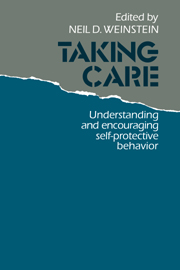Introduction: studying self-protective behavior
Published online by Cambridge University Press: 03 February 2010
Summary
Recent decades have seen an explosion of information about the hazards we face from natural and human-made sources and from our own life-styles. Some of these hazards, such as acid rain, toxic shock syndrome, autoimmune deficiency syndrome (AIDS), and nuclear winter, are new discoveries. Other potential dangers, such as pesticides in food, can be detected at lower levels than ever before. Masses of data and vivid media images impress us with the magnitude of the losses caused by hazards. On the individual level, risk factor analyses make us wonder whether we are the ones particularly susceptible to harm. At the same time, new counter-measures are available to reduce these risks, including the installation of smoke detectors and automobile air bags and the use of anti-cholesterol drugs.
The information we receive about the hazards in our environment is certainly a mixed blessing. Some problems, like the small amounts of carcinogens found in drinking water, are so difficult to avoid that warnings may just create feelings of frustration and futility. And individuals acting alone can do little to reduce the risk of nuclear war. Most problems, however, are not so intractable. Hazard information often suggests ways of decreasing our vulnerability. The recognition of a link between asbestos and lung disease, for example, has led people to reduce the amount of asbestos in their environment and has diminished the risk of asbestos-caused illness.
The growing hazard awareness in our society has contributed to an unprecedented interest in prevention.
- Type
- Chapter
- Information
- Taking CareUnderstanding and Encouraging Self-Protective Behavior, pp. 1 - 10Publisher: Cambridge University PressPrint publication year: 1987
- 5
- Cited by



